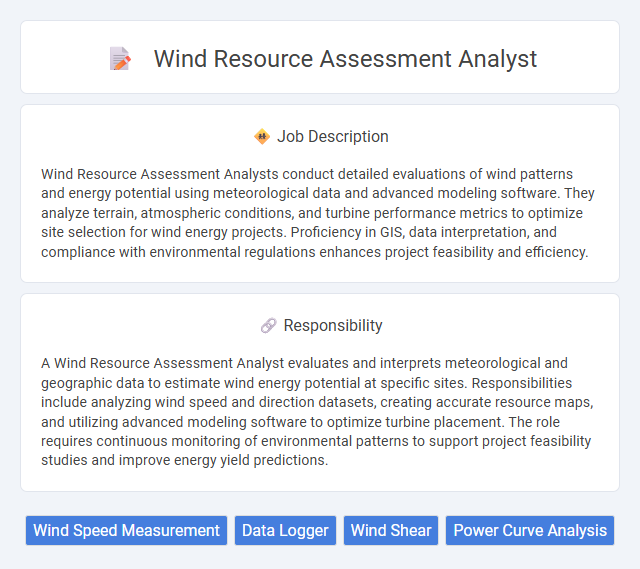
Wind Resource Assessment Analysts conduct detailed evaluations of wind patterns and energy potential using meteorological data and advanced modeling software. They analyze terrain, atmospheric conditions, and turbine performance metrics to optimize site selection for wind energy projects. Proficiency in GIS, data interpretation, and compliance with environmental regulations enhances project feasibility and efficiency.
Individuals with strong analytical skills and a passion for renewable energy are likely to find the role of a Wind Resource Assessment Analyst suitable. Candidates comfortable working with meteorological data, GIS tools, and statistical software might experience higher job satisfaction and effectiveness. Those who prefer fieldwork combined with data analysis could also thrive in this dynamic and evolving industry.
Qualification
Wind Resource Assessment Analysts require a strong foundation in meteorology, atmospheric sciences, or renewable energy engineering, with proficiency in data analysis and modeling software such as WAsP, WindPRO, or MATLAB. Experience in interpreting meteorological data, conducting site resource evaluations, and familiarity with GIS tools are critical for accurate wind potential estimation. Certifications in renewable energy or specialized training in wind resource assessment methodologies enhance a candidate's qualifications significantly.
Responsibility
A Wind Resource Assessment Analyst evaluates and interprets meteorological and geographic data to estimate wind energy potential at specific sites. Responsibilities include analyzing wind speed and direction datasets, creating accurate resource maps, and utilizing advanced modeling software to optimize turbine placement. The role requires continuous monitoring of environmental patterns to support project feasibility studies and improve energy yield predictions.
Benefit
Wind Resource Assessment Analysts likely provide critical insights that enhance the accuracy of wind energy project planning, potentially leading to optimized turbine placement and increased energy yield. Their expertise probably contributes to reducing project risks and ensuring cost-effective investments by predicting wind patterns with higher reliability. This role may significantly improve the overall efficiency and sustainability of renewable energy initiatives.
Challenge
Wind Resource Assessment Analyst roles likely involve complex challenges in accurately interpreting dynamic meteorological data to predict wind patterns. The position probably requires advanced proficiency in modeling software and the ability to manage uncertainties inherent in environmental variables. Addressing these challenges is essential for optimizing wind energy project feasibility and performance.
Career Advancement
Wind Resource Assessment Analysts specialize in evaluating wind data to optimize site selection and turbine performance, playing a critical role in renewable energy projects. Expertise in meteorological data analysis, GIS software, and atmospheric modeling enhances opportunities for leadership roles within project management or consultancy. Continuous skill development in emerging technologies and regulatory compliance drives career growth toward senior positions like Wind Energy Project Developer or Environmental Consultant.
Key Terms
Wind Speed Measurement
Wind Resource Assessment Analysts specialize in precise wind speed measurement using advanced anemometry techniques and meteorological data analysis to evaluate wind potential for energy projects. They deploy and maintain instruments like cup anemometers, sonic anemometers, and LiDAR to collect high-resolution wind speed data across different heights and time scales. Their expertise in statistical wind data processing and site-specific wind flow modeling enables accurate estimation of energy yields and optimization of turbine placement.
Data Logger
A Wind Resource Assessment Analyst specializing in Data Logger technologies ensures accurate measurement of wind speed, direction, and turbulence by deploying and maintaining advanced data logging instruments at meteorological towers. These analysts process high-resolution time series data to evaluate wind patterns, optimize turbine placement, and support financial feasibility studies for wind energy projects. Proficiency in configuring data loggers, troubleshooting sensor calibration, and analyzing data integrity is essential for maximizing the reliability of wind resource assessments.
Wind Shear
Wind Resource Assessment Analysts specialize in evaluating wind shear profiles to optimize turbine placement and energy output. They analyze vertical wind speed variations using LiDAR, SODAR, and meteorological towers to ensure accurate wind resource characterization. Precise wind shear measurement supports improved forecast models and reduces turbine load uncertainties, enhancing project profitability and operational efficiency.
Power Curve Analysis
A Wind Resource Assessment Analyst specializing in Power Curve Analysis evaluates the relationship between wind speed and turbine output to optimize energy production. They utilize met mast data, SCADA systems, and statistical modeling to verify turbine performance and identify deviations or underperformance. Expertise in power curve validation ensures accurate energy yield predictions and supports effective project financing and operational decisions.
 kuljobs.com
kuljobs.com